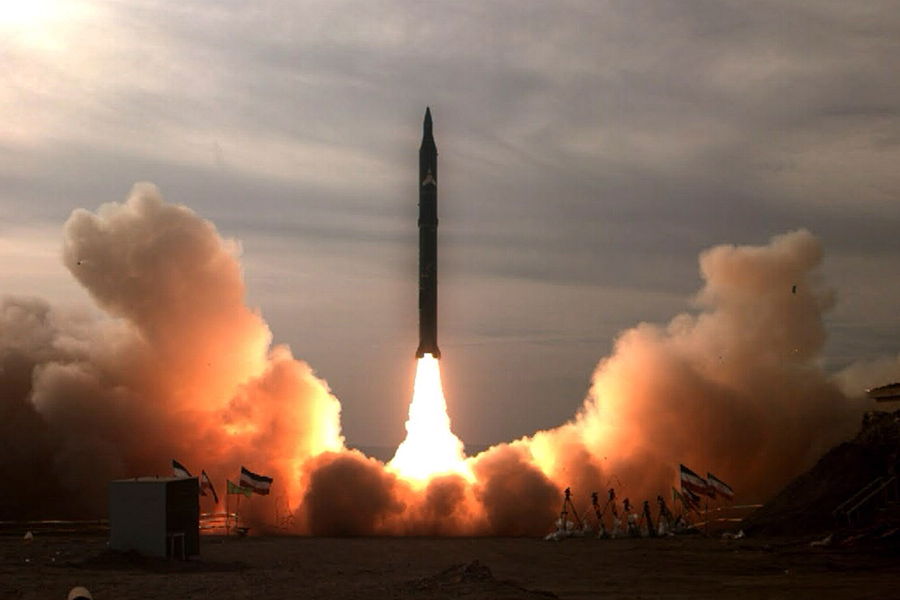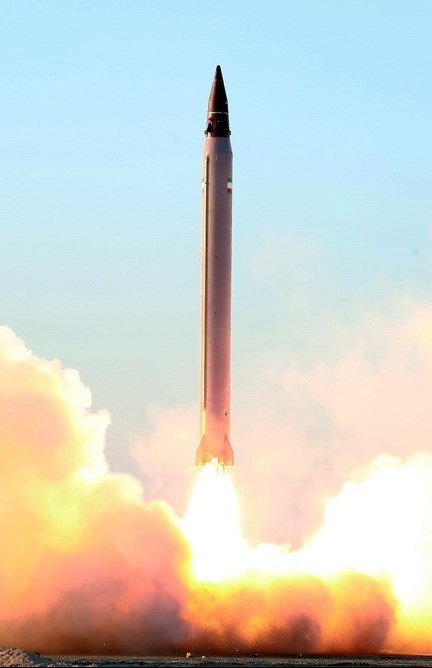Iran Tests Missile With Two-Tonne Warhead, Showcasing Breakthrough in Long-Range Strike Capability
The announcement was made by Iranian Defense Minister Brigadier General Aziz Nasirzadeh, who revealed to reporters in Tehran that the test marked a significant leap forward in the Islamic Republic’s indigenous missile development efforts.
(DEFENCE SECURITY ASIA) — In a bold display of its expanding strategic strike capabilities, Iran has successfully conducted a high-impact missile test featuring a domestically developed two-tonne warhead, a move that could recalibrate regional deterrence dynamics and send ripples across global defence establishments.
The announcement was made by Iranian Defense Minister Brigadier General Aziz Nasirzadeh, who revealed to reporters in Tehran that the test marked a significant leap forward in the Islamic Republic’s indigenous missile development efforts.
“We have made very good progress in defense affairs,” Nasirzadeh stated, highlighting that Iran’s armed forces are fully equipped and hold the upper hand in any potential military confrontation.
The minister further warned that any act of aggression by the United States would provoke a swift and devastating response, underlining Iran’s readiness to impose heavy losses on American forces stationed in the region.
Speaking on the sidelines of a cabinet meeting, Nasirzadeh reiterated, “Iran’s armed forces are fully equipped and have the upper hand in any conflict,” adding that Tehran’s deterrent posture was more robust than ever.
He also dismissed recent inflammatory comments from U.S. military officials, noting, “Every so often, it is said that if negotiations fail, it will lead to a conflict. On behalf of the Iranian nation, I declare that in case a conflict is imposed upon us, we will strike our designated targets, the enemy will suffer heavy casualties, and America must leave the region.”
The successful missile test, which involved the deployment of a two-tonne warhead, demonstrates Iran’s mastery of multiple high-end military technologies, including advanced propulsion, aerodynamics, and structural engineering—critical components for long-range, high-payload missile systems.

The test reinforces Iran’s evolving missile doctrine, which increasingly favours precision-strike capabilities capable of penetrating hardened military infrastructure and outmatching regional missile defence shields.
Abbas Kharabaf, a defence and aerospace expert who has closely monitored Iran’s missile developments, told the Tehran Times that “maintaining structural integrity while carrying a 2-ton payload at hypersonic speeds requires breakthroughs in materials science, aerodynamics, and propulsion.”
He added that the achievement signals a maturing Iranian aerospace sector, noting that the heavy warhead can be deployed aboard Iran’s operational medium- and long-range ballistic missile platforms, including the Khorramshahr and Emad systems.
Both of these platforms have operational ranges that cover Israel, U.S. military bases in the Gulf, and potentially parts of southern Europe, making the two-tonne payload capability a strategic game-changer.
Kharabaf revealed that the newly tested warhead features a triconic (three-cone) aerodynamic design, significantly reducing radar cross-section and enhancing survivability against advanced missile defence systems such as THAAD and the Israeli Arrow system.
He also noted the warhead’s integration of sophisticated thermal shielding, enabling it to survive hypersonic atmospheric reentry, while its maneuverable reentry vehicle (MaRV) capability allows it to adjust trajectory during the terminal phase, increasing strike accuracy and complicating interception.
Such technological characteristics suggest that the warhead is designed for counterforce operations, capable of targeting fortified military infrastructure such as underground command-and-control centres, aircraft bunkers, ballistic missile silos, fuel depots, and reinforced airbases.

“Its strategic value lies in the combination of speed, precision, and payload,” said Kharabaf, adding, “This development isn’t just about one weapon—it’s about Iran establishing itself as a serious player in advanced missile technology.”
The timing of the announcement is particularly significant as the region faces heightened geopolitical friction, with ongoing Israeli strikes in Syria, renewed tensions in the Strait of Hormuz, and a hardening U.S. stance against Iranian regional influence.
The missile test may also serve as a strategic message to Gulf Cooperation Council (GCC) states, particularly Saudi Arabia and the UAE, who have recently expanded military cooperation with Israel and the United States under the Abraham Accords security framework.
Iran’s missile developments, including its latest two-tonne warhead test, reflect a long-standing effort to shift from asymmetrical retaliation strategies to a credible, high-impact deterrent model based on strategic-range precision firepower.
While Western powers continue to voice concern over Iran’s missile program, Tehran views these tests as essential to preserving its sovereignty in a region increasingly dominated by foreign military presence and multi-layered missile defence systems.
With this breakthrough, Iran joins a small group of nations capable of deploying heavy-payload maneuverable reentry vehicles, a capability that significantly complicates enemy air defence planning and adds a new dimension to Tehran’s military deterrence posture.
As negotiations over the nuclear deal remain stalled and tensions simmer across flashpoints from Syria to the Gulf, the latest test underscores Iran’s resolve to develop an independent, technologically advanced, and regionally dominant missile force.

The Devastating Impact of a Missile Armed with a Two-Tonne Warhead
The successful test of a missile armed with a two-tonne warhead, as recently reported by Iran, has raised significant alarm among global defence analysts, with experts warning that such a payload carries the potential to deliver devastating kinetic and strategic effects on modern battlefields.
Capable of obliterating hardened military installations, fortified airbases, and underground command centres, a missile carrying a 2,000 kg warhead is not just a weapon—it is a message of deterrence, escalation, and deep-penetrating strike capability.
In military terms, a conventional high-explosive warhead of this magnitude can create a blast radius capable of collapsing reinforced concrete structures within a 30 to 50-meter radius, with severe secondary damage stretching well beyond 100 meters, depending on the altitude and angle of detonation.
The destructive potential is especially relevant against deeply buried targets such as aircraft shelters, fuel depots, ammunition bunkers, and subterranean military headquarters, many of which are designed to resist standard munitions.
Such a warhead, when paired with a long-range ballistic or hypersonic missile, transforms into a strategic-level asset, giving the launching country the ability to neutralize critical enemy infrastructure far beyond its borders.
Beyond physical damage, the psychological and operational shockwave is just as potent.
Military commanders must now contend with the reality that no facility—however deeply buried or heavily reinforced—is safe from a two-tonne payload delivered at hypersonic speeds.
This capability forces adversaries to drastically reconsider deployment patterns, fortification strategies, and the overall survivability of their high-value assets.

Furthermore, if the warhead features maneuverable reentry vehicle (MaRV) capabilities, as claimed by Iranian experts, it becomes significantly harder to intercept using current-generation air defence systems such as THAAD, Patriot PAC-3, or Israel’s Arrow-3.
This not only weakens the effectiveness of layered missile defence but also increases the cost of maintaining credible deterrence against such threats.
From a geostrategic standpoint, the ability to deliver such a high-mass warhead across continental distances shifts the regional power balance.
Missiles equipped with two-tonne warheads—especially when deployed on platforms like Iran’s Khorramshahr or Emad—can reach targets across the Middle East, South Asia, and even parts of Europe.
If nuclear warhead miniaturization is considered—a capability well within the carrying capacity of a two-tonne payload—the implications spiral into global arms control territory, triggering concerns of escalation and potential arms races among rival powers.
Military analysts point to the classic formula: speed + precision + payload = strategic impact—a combination that such missiles now offer to their operators.


